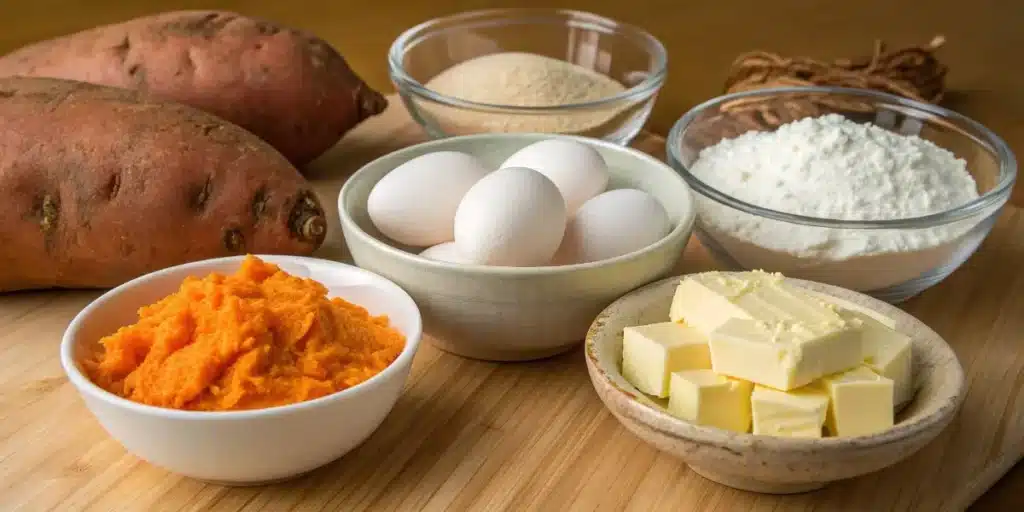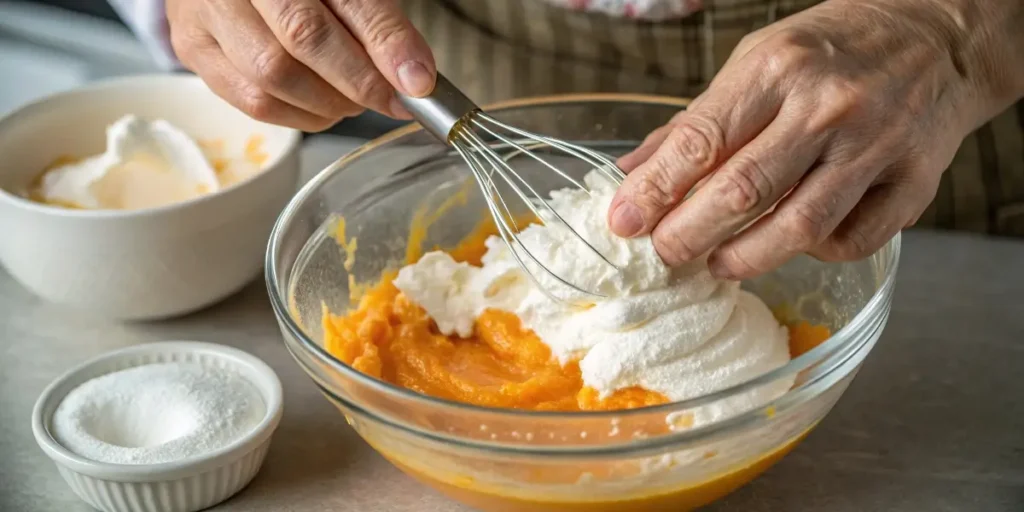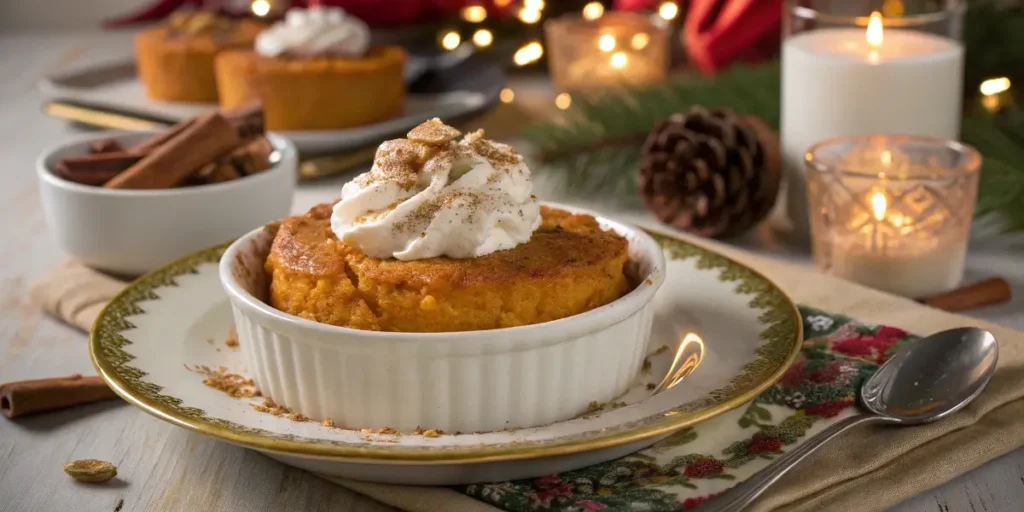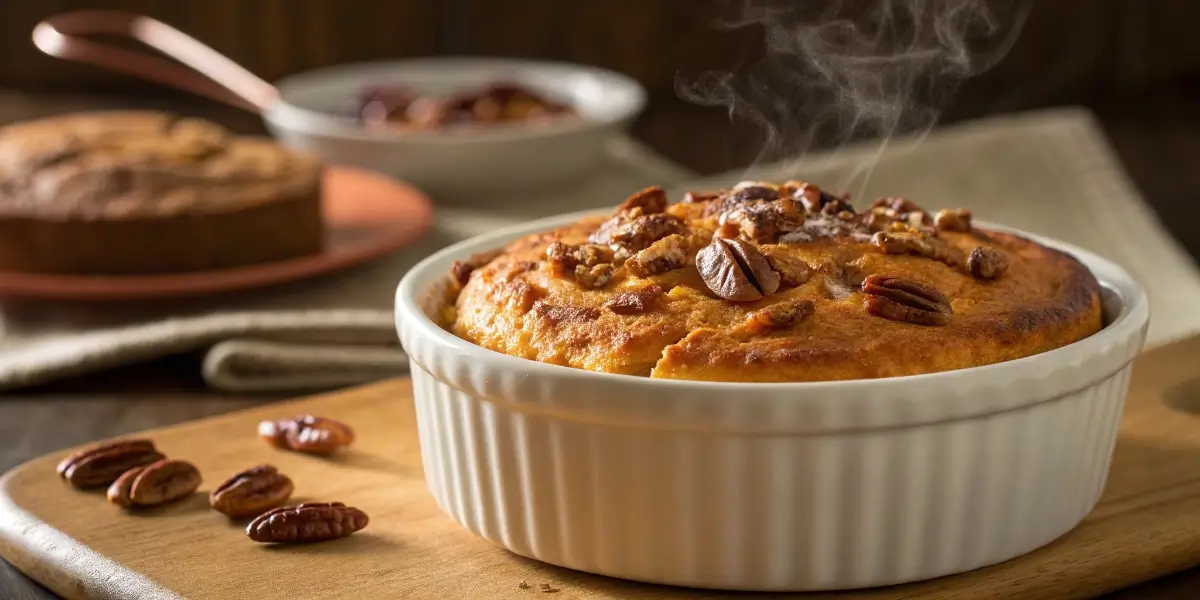Recipe for Sweet Potato Souffle — A Fluffy, Sweet, and Comforting Southern Classic
The recipe for sweet potato souffle is a timeless Southern treasure that brings comfort and elegance to any table. This dish is known for its irresistibly smooth, airy texture and the perfect harmony between sweet and savory flavors. Whether it’s served alongside a Thanksgiving turkey or as a decadent weeknight side, the sweet potato souffle adds warmth and nostalgia to every meal. Rooted in Southern tradition, this recipe transforms humble sweet potatoes into a golden, velvety masterpiece — rich, light, and utterly satisfying.
Learn more about other comforting classics by visiting Delicious Acorn Squash Recipes.
Table of Contents
Introduction to Sweet Potato Souffle
The Legacy of Sweet Potato Souffle in Southern Cuisine
The recipe for sweet potato souffle has long been a beloved dish across Southern households, where food is more than nourishment — it’s a celebration of family, flavor, and heritage. Each spoonful carries the essence of tradition, blending the creamy richness of mashed sweet potatoes with buttery, sugary notes that make it both a side and a dessert. The dish gained popularity for its versatility and simplicity, turning pantry staples into something extraordinary. Whether topped with toasted pecans or a caramelized crust, this dish remains a signature at holiday gatherings, especially Thanksgiving and Christmas.
Many cooks have their own twist — some add orange zest for brightness, while others blend vanilla and brown sugar for deeper warmth. No matter how it’s prepared, the sweet potato souffle has earned its place as a Southern comfort staple.
Why This Recipe for Sweet Potato Souffle is a Must-Try
This recipe for sweet potato souffle stands out for its unbeatable texture and balanced sweetness. Roasted sweet potatoes bring out a natural caramel flavor that pairs perfectly with eggs, butter, and cream. When baked, the mixture puffs slightly, creating a cloud-like consistency with a golden, slightly crisp top. It’s indulgent but not heavy — making it ideal for any occasion.
The best part? It’s incredibly easy to make, even for beginners. With simple ingredients and foolproof steps, you’ll have a restaurant-quality souffle right at home. Plus, it’s versatile enough to pair with both savory and sweet main dishes.
Discover great ideas like Paula Deen Sweet Potato Casserole, which has inspired countless home cooks to elevate their own souffle recipes.
Understanding the Basics of a Souffle
What Makes a Souffle Different from a Casserole
When people first hear about a recipe for sweet potato souffle, they often mistake it for a casserole. However, the difference lies in texture and technique. A souffle, by nature, is lighter and fluffier because it incorporates whipped eggs to give it lift as it bakes. A casserole, on the other hand, is typically denser and heartier, often layered with toppings or mixed ingredients that don’t rise.
In a sweet potato souffle, the whipped egg whites are gently folded into the sweet potato base, allowing the mixture to expand in the oven, creating that signature airy quality that sets it apart. While casseroles are comfort food classics, souffles are about elegance, balance, and that beautiful golden top that hints at its delicate interior.
Check out Roasted Butternut Squash Recipe for another light yet comforting side dish idea.
Core Ingredients That Create the Signature Fluffiness
A great recipe for sweet potato souffle depends on simple but high-quality ingredients. Start with freshly baked or roasted sweet potatoes—these deliver a richer, deeper sweetness compared to boiled ones. Butter adds richness, while sugar enhances the natural flavor. Eggs are the true stars; the yolks add structure and color, and the whipped whites create lift. A touch of milk or cream smooths the texture, and vanilla or cinnamon adds aromatic depth. For a finishing touch, some bakers sprinkle brown sugar or crushed pecans on top to achieve that caramelized, lightly crisp layer.
Discover great ideas like Gluten-Free Side Dishes if you’re looking for light, airy recipes with texture and flavor balance.
Ingredients for the Perfect Sweet Potato Souffle

Essential Ingredients You’ll Need for This Recipe
A perfect recipe for sweet potato souffle starts with selecting the best ingredients. You’ll need about three cups of mashed sweet potatoes—roasted, not boiled, for maximum sweetness and texture. Add melted butter for richness, granulated sugar for sweetness, and a hint of vanilla extract to deepen the flavor. Eggs are essential; they provide structure and lift, giving the souffle its delicate rise. A splash of milk or heavy cream helps to create that creamy consistency, while a pinch of salt enhances the overall taste balance.
Here’s a quick look at the ingredient list for reference:
| Ingredient | Quantity | Purpose |
|---|---|---|
| Sweet Potatoes | 3 cups, mashed | Base flavor and texture |
| Butter | ½ cup, melted | Adds richness |
| Sugar | ¾ cup | Sweetens the souffle |
| Eggs | 3, separated | Provides structure and rise |
| Milk or Cream | ½ cup | Smooths texture |
| Vanilla Extract | 1 tsp | Enhances aroma |
| Salt | ¼ tsp | Balances sweetness |
| Optional: Pecans, Brown Sugar | As desired | Adds crunch and depth |
If you enjoy exploring variations, check out Gluten-Free Waffle Recipe to learn how fluffy batters depend on ingredient ratios.
Optional Add-ins and Flavor Enhancers for a Unique Twist
While the traditional recipe for sweet potato souffle is already divine, a few tweaks can make it unforgettable. Consider adding a hint of orange zest or maple syrup for a bright, aromatic twist. Crushed pecans or walnuts give a satisfying crunch, while a touch of cinnamon or nutmeg warms up the flavor profile. For a dessert-like version, a marshmallow topping can be added during the final minutes of baking for a golden, gooey finish. Want to make it healthier? Substitute half the sugar with honey or coconut sugar for a more natural sweetness without compromising texture.
Looking for inspiration? Try our Delicious Ground Beef Crock Pot Recipes.
Step-by-Step Instructions for Making Sweet Potato Souffle
Preparing and Whipping the Sweet Potatoes for the Base
To make a truly irresistible recipe for sweet potato souffle, start with perfectly cooked sweet potatoes. Preheat your oven to 400°F and roast whole sweet potatoes until they’re fork-tender — usually around 45 minutes. Roasting helps caramelize their natural sugars, creating a deeper, richer flavor. Once cooled, peel and mash them until smooth, removing any lumps. In a large mixing bowl, combine the mashed sweet potatoes with melted butter, sugar, milk, vanilla extract, and egg yolks. Mix until creamy and uniform.
Now comes the key to a light, airy souffle — whipping the egg whites. Using a clean, dry bowl, beat the egg whites with a hand or stand mixer until stiff peaks form. Gently fold the whipped egg whites into the sweet potato mixture using a spatula, being careful not to deflate them. This step is what creates the souffle’s delicate rise and signature fluffiness.
Learn more about perfect mixing techniques from our Cottage Cheese Desserts guide for smooth, airy textures in sweet recipes.

Mixing, Folding, and Baking Techniques for a Light Texture
Once the base mixture is ready, lightly butter your baking dish or individual ramekins to prevent sticking. Pour in the batter, leaving some space at the top for rising. For extra flavor and crunch, sprinkle a topping made of brown sugar, butter, and chopped pecans. Bake at 350°F for 30–35 minutes or until the top is golden brown and slightly puffed. The center should be soft but set.
Avoid opening the oven door while baking — sudden temperature changes can cause the souffle to collapse. Once done, let it cool for a few minutes before serving. The sweet potato souffle is best enjoyed warm, with its pillowy texture and caramelized aroma filling your kitchen.
Check out our Amish Apple Cake Recipe for another baked dish that balances texture and sweetness perfectly.
Tips and Secrets for a Fluffy, Airy Souffle
The Secret to Achieving the Perfect Rise Every Time
Every recipe for sweet potato souffle relies on one main principle — air. The goal is to trap air inside the mixture so that it puffs beautifully when baked. The secret begins with separating the eggs correctly and ensuring the whites are whipped to stiff, glossy peaks. Never rush this step; under-whipped whites make the souffle dense, while over-whipped ones make it grainy. When folding them into the base, do it gently in a figure-eight motion. This preserves the air bubbles that give the souffle its signature lift.
Another crucial tip is temperature. Make sure all ingredients, especially eggs and milk, are at room temperature before mixing. Cold ingredients can cause the batter to seize, resulting in uneven texture. Finally, preheat your oven fully before baking and avoid opening the door during cooking — even a slight drop in temperature can deflate the souffle.
Looking for inspiration on temperature control and texture? Check out Delicious Toll House Cookies where perfect baking balance makes all the difference.
Common Mistakes When Making a Sweet Potato Souffle (and How to Avoid Them)
Even the most experienced bakers can face pitfalls when making a souffle. One of the most common mistakes is overmixing the batter, which eliminates the air pockets needed for that delicate rise. Another is using cold mashed sweet potatoes — always ensure they’re warm or at least room temperature when blending in butter and eggs. Greasing the baking dish improperly can also cause sticking, which ruins presentation.
If your souffle deflates quickly after baking, it might have been underbaked or removed from the oven too soon. To test doneness, insert a toothpick in the center — it should come out clean but slightly moist. Also, make sure your oven rack is centered; baking too close to the top can brown the surface too early.
For more baking perfection tips, explore Perfect Boston Cream Cake, which also depends on precise temperature and timing.
Serving and Pairing Ideas for Sweet Potato Souffle
How to Serve Sweet Potato Souffle for Maximum Appeal
A recipe for sweet potato souffle deserves a presentation as stunning as its flavor. Serve it warm, straight from the oven, when the top is golden and slightly puffed. Use a large serving spoon to gently scoop portions, showcasing the contrast between the light, airy top and creamy interior. For family dinners or holidays, bake it in a glass or ceramic dish so guests can see the layers. A sprinkle of powdered sugar or a drizzle of maple syrup enhances its appeal if served as dessert.
For a more elegant setting, bake the souffle in individual ramekins for single servings — perfect for dinner parties. Pair it with roasted turkey, ham, or even grilled chicken for a sweet-savory balance. If you prefer it on the dessert table, top it with whipped cream or a pecan crumble for added richness.
Discover great plating and serving inspiration from Delicious Mexican Cornbread Casserole, which shows how presentation transforms comfort food into a centerpiece.

Perfect Pairings — What to Serve Alongside Your Souffle
Sweet potato souffle pairs beautifully with a wide variety of main dishes and sides. Its sweetness complements savory proteins like roast turkey, baked ham, or herb-roasted chicken. For texture balance, serve it with something crisp — perhaps a green bean almondine or a fresh salad with citrus dressing.
If you’re serving it as dessert, add a scoop of vanilla ice cream or a dollop of homemade whipped cream. A warm cup of coffee, cinnamon tea, or mulled cider also enhances the cozy flavors. You can even transform leftover souffle into a creative breakfast — just reheat and top with honey or Greek yogurt.
Looking for inspiration? Check out Panera Turkey Chili Recipe for a hearty, savory dish that pairs perfectly with souffle.
Make-Ahead and Storage Tips
Can You Prepare Sweet Potato Souffle Ahead of Time?
Yes! One of the best things about this recipe for sweet potato souffle is that it can easily be made ahead of time without losing its signature texture. If you’re planning a big meal, this trick will save you plenty of time on the day of serving. Prepare the base mixture as directed, but hold off on baking. Instead, pour the mixture into your prepared baking dish, cover it tightly with plastic wrap or foil, and refrigerate for up to 24 hours. When you’re ready to serve, let it sit at room temperature for about 30 minutes before baking to ensure even cooking.
You can also freeze the souffle base for up to one month. Just thaw it overnight in the refrigerator, then fold in freshly whipped egg whites right before baking. This step ensures the souffle still rises beautifully.
Discover more make-ahead comfort foods in our Biscuits and Gravy Casserole, a perfect breakfast option for busy mornings.
How to Store and Reheat Without Losing Texture
Proper storage and reheating techniques are key to keeping your souffle as fluffy and delicious as when it first came out of the oven. After serving, allow the dish to cool completely before covering it tightly with foil or transferring it to an airtight container. Store leftovers in the refrigerator for up to 3 days.
To reheat, avoid the microwave — it tends to make the souffle soggy and heavy. Instead, warm it in the oven at 325°F for about 15–20 minutes. Cover it with foil to prevent over-browning. For smaller portions, individual ramekins reheat perfectly without compromising the texture.
For more oven-friendly reheating ideas, check out Delicious Brioche French Toast Casserole.
Variations and Healthier Alternatives
Vegan and Gluten-Free Sweet Potato Souffle Options
For those looking to make the recipe for sweet potato souffle more inclusive, there are easy substitutions to make it both vegan and gluten-free without compromising flavor or texture. Replace the eggs with aquafaba (the liquid from canned chickpeas) — three tablespoons equal one egg white. It whips beautifully, just like traditional egg whites, giving the souffle that same airy lift. Use coconut milk or almond milk instead of dairy, and swap the butter for coconut oil or vegan butter. These alternatives add a subtle richness while keeping the dish plant-based.
For gluten-free diets, this recipe is naturally flourless, but if you prefer a slightly firmer structure, a teaspoon of cornstarch or arrowroot powder can be added. It helps bind the ingredients and creates a more cohesive texture. If you’re making a topping, be sure to use gluten-free oats or nut-based crumbles.
Looking for more allergy-friendly options? Check out Gluten-Free Summer Salads and Gluten and Dairy-Free Dessert Ideas for inspiration on light, wholesome dishes that fit any dietary need.
Creative Twists: Nut Toppings, Spices, and Seasonal Additions
Once you’ve mastered the classic version, it’s time to have some fun with flavor. The recipe for sweet potato souffle can be customized endlessly. For fall and winter, try adding warm spices like cinnamon, nutmeg, or allspice. If you love texture, top it with crushed pecans, almonds, or granola. You can even mix a bit of maple syrup or orange zest into the base for a subtle twist.
Feeling indulgent? Add a swirl of cream cheese before baking or sprinkle crushed gingersnaps on top for a holiday-ready dessert. For a lighter summer variation, fold in shredded coconut or drizzle with honey before serving. The possibilities are endless, and each version adds a new layer of flavor to this beloved classic.
Don’t miss our Blueberry Cottage Cheese Breakfast Bake for another twist on rich, sweet, and fluffy baked recipes.
Conclusion
The recipe for sweet potato souffle perfectly captures the heart of Southern comfort food — warm, sweet, and beautifully airy. Whether you serve it as a side dish or a dessert, its creamy base and lightly crisp top make every bite irresistible. This dish isn’t just about flavor; it’s about nostalgia, family, and creating something special from simple ingredients.
The beauty of this souffle lies in its flexibility. It can be prepared ahead, adapted for dietary needs, and dressed up for any occasion. The combination of roasted sweet potatoes, whipped egg whites, and rich butter creates a dish that feels luxurious but remains easy to make. Whether you prefer it with pecans, marshmallows, or a hint of spice, this recipe ensures your table will shine.
Looking for inspiration? Try our Delicious Spiced Cajun Turkey Recipe for a savory main dish that complements the souffle’s sweetness, or explore Delicious Carnivore Diet Recipes for hearty alternatives.
FAQs
What goes in sweet potato souffle?
A traditional recipe for sweet potato souffle includes roasted sweet potatoes, butter, sugar, eggs, milk or cream, and vanilla extract. These create the rich, fluffy base. For added flavor and texture, many cooks top the souffle with a pecan-brown sugar crumble or marshmallows for a sweet finish. The goal is to balance natural sweetness with smooth creaminess.
What ingredients are in a basic soufflé?
A classic soufflé, whether savory or sweet, usually contains eggs (separated), sugar, and a base mixture such as sweet potatoes, chocolate, or cheese. The whipped egg whites are what give a soufflé its iconic lift and airy structure. The yolks add richness and depth to the flavor.
What is the secret to a good soufflé?
The secret lies in the technique. Whip your egg whites to stiff peaks and fold them in gently to maintain airiness. Room temperature ingredients are also essential for even blending. Finally, bake the souffle in a preheated oven and avoid opening the door while baking to prevent deflation.
What’s the difference between a soufflé and a casserole?
Though both are baked dishes, a soufflé is light, airy, and rises due to whipped egg whites, while a casserole is dense and hearty. The sweet potato souffle recipe offers the best of both — creamy and sweet like a casserole but with the delicate lift of a soufflé.
What are common mistakes when making soufflé?
Overmixing the batter, using cold ingredients, and under-whipping egg whites are the top mistakes. Opening the oven door during baking or overbaking can also cause it to collapse or dry out. Following precise timing and gentle folding ensures a perfectly puffed souffle every time.
Can you prepare sweet potato souffle ahead of time?
Yes! You can make the base ahead of time and refrigerate it for up to 24 hours. Just fold in freshly whipped egg whites before baking. It can also be frozen — simply thaw overnight before baking. This flexibility makes it a holiday favorite.

